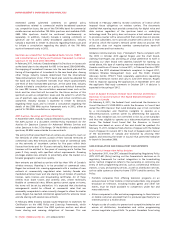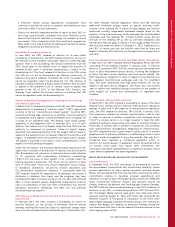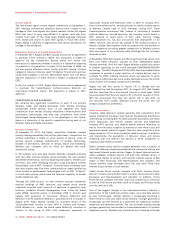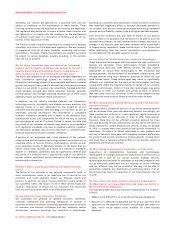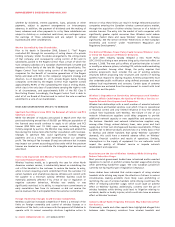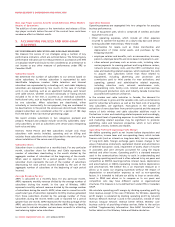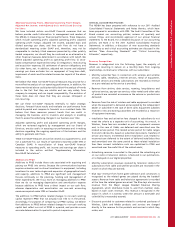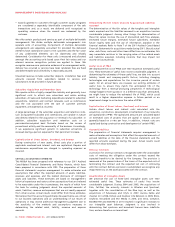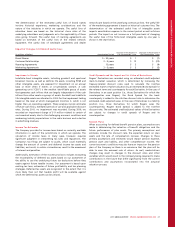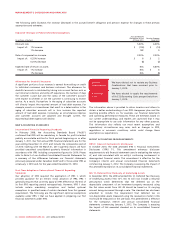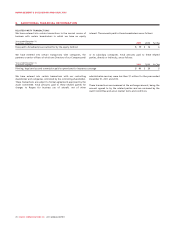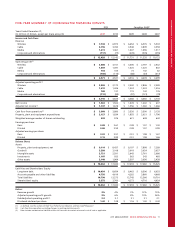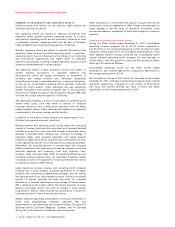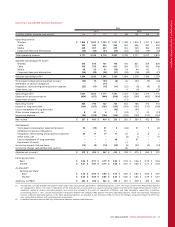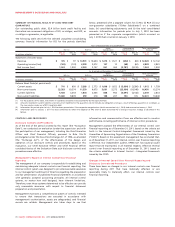Rogers 2011 Annual Report Download - page 68
Download and view the complete annual report
Please find page 68 of the 2011 Rogers annual report below. You can navigate through the pages in the report by either clicking on the pages listed below, or by using the keyword search tool below to find specific information within the annual report.
MANAGEMENT’S DISCUSSION AND ANALYSIS
Blue Jays Player Contract Activity Could Adversely Affect Media’s
Results of Operations.
The addition of new players or the termination and release of Blue
Jays player contracts before the end of the contract term could have
an adverse effect on Media’s results.
5. ACCOUNTING POLICIES AND NON-GAAP
MEASURES
KEY PERFORMANCE INDICATORS AND NON-GAAP MEASURES
We measure the success of our strategies using a number of key
performance indicators, which are outlined below. The following key
performance indicators are not measurements in accordance with IFRS
or Canadian GAAP and should not be considered as an alternative to
net income or any other measure of performance under IFRS or
Canadian GAAP.
Subscriber Counts
We determine the number of subscribers to our services based on
active subscribers. A wireless subscriber is represented by each
identifiable telephone number. Cable television and Internet
subscribers are represented by a dwelling unit, and cable telephony
subscribers are represented by line counts. In the case of multiple
units in one dwelling, such as an apartment building, each tenant
with cable service, whether invoiced individually or having services
included in his or her rent, is counted as an individual subscriber.
Institutional units, such as hospitals or hotels, are each considered to
be one subscriber. When subscribers are deactivated, either
voluntarily or involuntarily for non-payment, they are considered to
be deactivations in the period the services are discontinued. Wireless
prepaid subscribers are considered active for a period of 180 days
from the date of their last revenue-generating usage.
We report wireless subscribers in two categories: postpaid and
prepaid. Postpaid and prepaid include voice-only subscribers, data-
only subscribers, as well as subscribers with service plans integrating
both voice and data.
Internet, Home Phone and RBS subscribers include only those
subscribers with service installed, operating and on billing and
excludes those subscribers who have subscribed to the service but for
whom installation of the service was still pending.
Subscriber Churn
Subscriber churn is calculated on a monthly basis. For any particular
month, subscriber churn for Wireless and Cable represents the
number of subscribers deactivating in the month divided by the
aggregate number of subscribers at the beginning of the month.
When used or reported for a period greater than one month,
subscriber churn represents the sum of the number of subscribers
deactivating for each period incurred divided by the sum of the
aggregate number of subscribers at the beginning of each period
incurred.
Average Revenue Per User
ARPU is calculated on a monthly basis. For any particular month,
ARPU represents monthly revenue divided by the average number of
subscribers during the month. In the case of Wireless, ARPU
represents monthly network revenue divided by the average number
of subscribers during the month. ARPU, when used in connection with
a particular type of subscriber, represents monthly revenue generated
from those subscribers divided by the average number of those
subscribers during the month. When used or reported for a period
greater than one month, ARPU represents the monthly average of the
ARPU calculations for the period. We believe ARPU helps to identify
trends and to indicate whether we have been successful in attracting
and retaining higher value subscribers.
Operating Expenses
Operating expenses are segregated into two categories for assessing
business performance:
• Cost of equipment sales, which is comprised of wireless and cable
equipment costs; and
• Other operating expenses, which include all other expenses
incurred to operate the business on a day-to-day basis and service
existing subscriber relationships. These include:
• merchandise for resale, such as Video merchandise and
depreciation of Video rental assets, and purchases by The
Shopping Channel;
• employee salaries and benefits, such as remuneration, bonuses,
pension, employee benefits and stock-based compensation; and
• other external purchases, such as service costs, including inter-
carrier payments to roaming partners and long-distance carriers,
network service delivery costs, and the CRTC contribution levy;
sales and marketing related expenses, which represent the costs
to acquire new subscribers (other than those related to
equipment), including advertising and promotion and
commissions paid to third parties for new activations; and
operating, general and administrative related expenses,
including retention costs, network maintenance costs,
programming costs, facility costs, Internet and e-mail services,
printing and production costs, and Industry Canada license fees
associated with spectrum utilization.
In the wireless and cable industries in Canada, the demand for
services continues to grow and the variable costs, such as commissions
paid for subscriber activations, as well as the fixed costs of acquiring
new subscribers, are significant. Fluctuations in the number of
activations of new subscribers from period-to-period and the seasonal
nature of both wireless and cable subscriber additions result in
fluctuations in sales and marketing related expenses and accordingly,
in the overall level of operating expenses. In our Media business, sales
and marketing related expenses may be significant to promote
publishing, radio and television properties, which in turn attract
advertisers, viewers, listeners and readers.
Operating Profit and Operating Profit Margin
We define operating profit as net income before depreciation and
amortization, income taxes and non-operating items, which include
finance costs (such as interest on long-term debt, loss on repayment
of long-term debt, foreign exchange gains (losses), change in fair
value of derivative instruments, capitalized interest and amortization
of deferred transaction costs), impairment of assets, share of income
in associates and joint ventures accounted for using the equity
method and other income. Operating profit is a standard measure
used in the communications industry to assist in understanding and
comparing operating results and is often referred to by our peers and
competitors as EBITDA (earnings before interest, taxes, depreciation
and amortization) or OIBDA (operating income before depreciation
and amortization). We believe this is an important measure as it
allows us to assess our ongoing businesses without the impact of
depreciation or amortization expenses as well as non-operating
factors. It is intended to indicate our ability to incur or service debt,
invest in PP&E and allows us to compare us to our peers and
competitors who may have different capital or organizational
structures. This measure is not a defined term under IFRS or Canadian
GAAP.
We calculate operating profit margin by dividing operating profit by
total revenue, except in the case of Wireless. For Wireless, operating
profit margin is calculated by dividing operating profit by network
revenue. Network revenue is used in the calculation, instead of total
revenue, because network revenue better reflects Wireless’ core
business activity of providing wireless services. Refer to the section
entitled “Supplementary Information: Non-GAAP Calculations” for
further details on this Wireless, Cable and Media calculation.
64 ROGERS COMMUNICATIONS INC. 2011 ANNUAL REPORT




